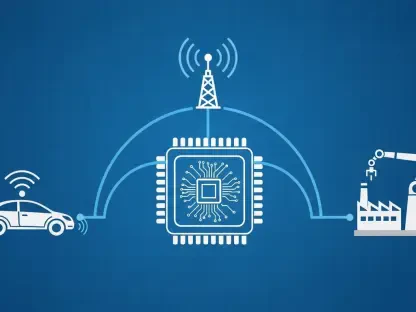Imagine a manufacturing plant where downtime is virtually eliminated, worker safety is enhanced through real-time monitoring, and energy efficiency drives both profitability and sustainability. This vision is becoming reality with the launch of a groundbreaking hub in Switzerland, spearheaded by Nokia in collaboration with key industry players. This roundup dives into diverse perspectives from technology leaders, industrial experts, and innovation advocates to explore how this initiative, focused on private 5G and AI edge technologies, is poised to transform industrial digitalization. The purpose is to gather a spectrum of opinions and actionable insights on how this hub can redefine operational excellence and democratize access to cutting-edge tools.
Unveiling a Catalyst for Industrial Transformation
Collaborative Vision for Digital Progress
Insights from technology consortiums highlight the significance of Nokia’s partnership with major entities like Datwyler IT Infra, Intel, and Switzerland Innovation Park Biel/Bienne (SIPBB). Industry observers note that this hub, based in Switzerland, represents a bold step toward creating an ecosystem where private 5G networks and AI edge solutions are not just concepts but practical tools for change. The consensus is that such collaborations can accelerate the adoption of advanced technologies across diverse sectors by pooling expertise and resources.
Many stakeholders emphasize the hub’s unique positioning to support startups and nonprofit organizations. By removing the financial burden of infrastructure setup, the initiative is seen as a game-changer for smaller players who often struggle to compete with larger corporations. This perspective underscores a growing belief that industrial innovation must be inclusive to drive meaningful economic impact on a broader scale.
A recurring theme among commentators is the strategic location of the hub in Switzerland, a country known for its innovation-friendly environment. Analysts suggest that this geographical advantage, combined with the collaborative framework, positions the hub as a potential magnet for global investment. The focus remains on how this setup can inspire similar models in other regions, fostering a ripple effect of technological advancement.
Challenges and Opportunities in Focus
While enthusiasm runs high, some industry watchers caution about the complexities of integrating 5G and AI into varied industrial settings. Opinions vary on how quickly these technologies can be scaled, with certain experts pointing to potential hurdles like interoperability issues and the need for specialized training. These challenges, however, are often framed as opportunities for iterative learning and adaptation within the hub’s testing environment.
Another point of discussion revolves around data privacy concerns in edge computing. Several technology ethicists argue that while localized processing offers speed and efficiency, it also raises questions about securing sensitive industrial data. Differing views emerge on whether current frameworks are robust enough, with some advocating for stricter regulations and others trusting in evolving tech solutions to address these risks.
Despite these concerns, optimism prevails regarding the hub’s role as a sandbox for innovation. Contributors from industrial forums highlight that the ability to test solutions in a controlled yet realistic setting can mitigate many risks before full-scale deployment. This balance of caution and ambition shapes the narrative around the hub’s potential to lead industrial digitalization.
Core Pillars of the Swiss Innovation Ecosystem
Harnessing Private 5G and Edge AI Capabilities
Technology specialists commend the hub’s foundation, built on Nokia’s Digital Automation Cloud (DAC) for private wireless networks and MX Industrial Edge (MXIE) for real-time data processing, complemented by powerful AI tools and Intel’s high-performance processors. Many agree that features like visual positioning and object detection are critical for modern industrial applications, offering unprecedented precision in operations. This technological synergy is often cited as a benchmark for future industry standards.
A notable perspective from digital transformation consultants is the emphasis on accessibility. The hub’s design to provide these advanced tools without prohibitive costs is seen as a step toward leveling the playing field for smaller enterprises. This democratization of technology sparks discussions on how such access can inspire a new wave of innovation from unexpected quarters in the industrial landscape.
However, some tech analysts raise concerns about the learning curve associated with these sophisticated systems. Opinions differ on whether industries are prepared to adopt such complex integrations without significant upskilling efforts. While some believe the hub’s supportive environment can bridge this gap, others suggest that broader educational initiatives may be necessary to ensure widespread readiness.
Transforming Operations with Practical Use Cases
Industrial engineers and operational leaders spotlight the hub’s focus on specific applications like predictive maintenance, which can drastically cut downtime and material waste in manufacturing. The ability to anticipate equipment failures before they occur is frequently described as a revolutionary shift, with many sharing optimism about cost savings and efficiency gains. These real-world applications are seen as proof of concept for broader industrial adoption.
Safety monitoring powered by AI also garners significant attention, with safety experts praising the potential to protect workers in high-risk environments through real-time alerts and interventions. Differing opinions exist on the reliability of these systems under varying conditions, with some urging continuous refinement to handle edge cases. Nonetheless, the consensus leans toward viewing this as a vital advancement for workplace security.
Scalability remains a point of contention among smaller business advocates. While the hub offers a testing ground, some express skepticism about translating these solutions to less-resourced entities without additional support. Others counter that the collaborative nature of the initiative could inspire tailored solutions, ensuring that even niche industries benefit from these innovations over time.
Prioritizing Sustainability in Industrial Growth
Sustainability consultants applaud the hub’s commitment to energy-efficient automation, viewing it as a critical trend for future industrial practices. Many note that aligning productivity with environmental goals is no longer optional but a competitive necessity. This perspective often ties into discussions on how the hub can set a precedent for green technology adoption across European industries.
Regional advantages in Switzerland, such as supportive policies and a culture of innovation, are frequently highlighted by economic analysts as catalysts for sustainable progress. Some speculate that success here could encourage other nations to replicate similar frameworks, potentially leading to a continental shift in industrial priorities. These insights fuel debates on balancing economic growth with ecological responsibility.
A fresh angle comes from environmental tech advocates who challenge conventional industrial growth models. They argue that the hub’s focus on sustainability proves that profitability and environmental stewardship can coexist. This viewpoint pushes for a redefinition of success metrics in industry, urging stakeholders to prioritize long-term impact over short-term gains.
Building an Inclusive Ecosystem for Innovation
Collaboration is a recurring theme among innovation strategists, who praise the hub’s role in fostering partnerships among startups, nonprofits, and established tech giants. This inclusive approach is often contrasted with more exclusive tech hubs globally, with many seeing it as a model for equitable growth. The narrative centers on creating a space where diverse ideas can converge and flourish.
Investment experts weigh in on the hub’s potential to attract funding by demonstrating tangible outcomes. While some believe the Swiss location naturally draws capital due to its reputation, others argue that consistent results from pilot projects will be key to sustaining interest. These differing views highlight the importance of measurable impact in securing long-term support for such initiatives.
A broader implication discussed by digital equity proponents is the reshaping of industrial hierarchies. By providing access to advanced tools, the hub is seen as empowering smaller players to influence the digital economy. This shift sparks varied opinions on whether traditional power dynamics in industry will adapt or resist, with many anticipating a gradual but transformative change.
Key Takeaways from Diverse Perspectives
Operational leaders and tech enthusiasts alike distill the hub’s significance into its ability to merge 5G and AI for tackling industrial challenges like efficiency and safety. A common tip is for businesses to engage with innovation hubs for pilot projects, leveraging shared resources to test concepts without heavy investment. This approach is often recommended as a low-risk entry into digital transformation.
Another practical insight focuses on workforce readiness for adopting these technologies. Many experts advise industries to prioritize training programs that build skills in AI and 5G integration, ensuring employees can maximize the tools’ potential. This preparation is viewed as essential for seamless implementation and long-term success in competitive markets.
For those outside direct industrial applications, suggestions include advocating for accessible digital tools within their sectors. Commentators encourage business leaders to explore partnerships or support policies that mirror the hub’s inclusive ethos. This broader engagement is seen as a way to amplify the initiative’s impact across diverse fields.
Reflecting on a Milestone in Industrial Innovation
Looking back, the insights gathered from various voices paint a vivid picture of how Nokia’s hub in Switzerland became a beacon for industrial digitalization through 5G and AI integration. The discussions captured a blend of optimism and pragmatism, highlighting both transformative potential and actionable challenges that shaped the initiative’s early journey. Moving forward, stakeholders are encouraged to consider forming strategic alliances with similar hubs to pilot innovative solutions tailored to their unique needs. Additionally, investing in community-driven programs to expand access to such technologies could ensure that the benefits of this progress reach beyond traditional industrial giants, fostering a more inclusive digital landscape for years to come.









